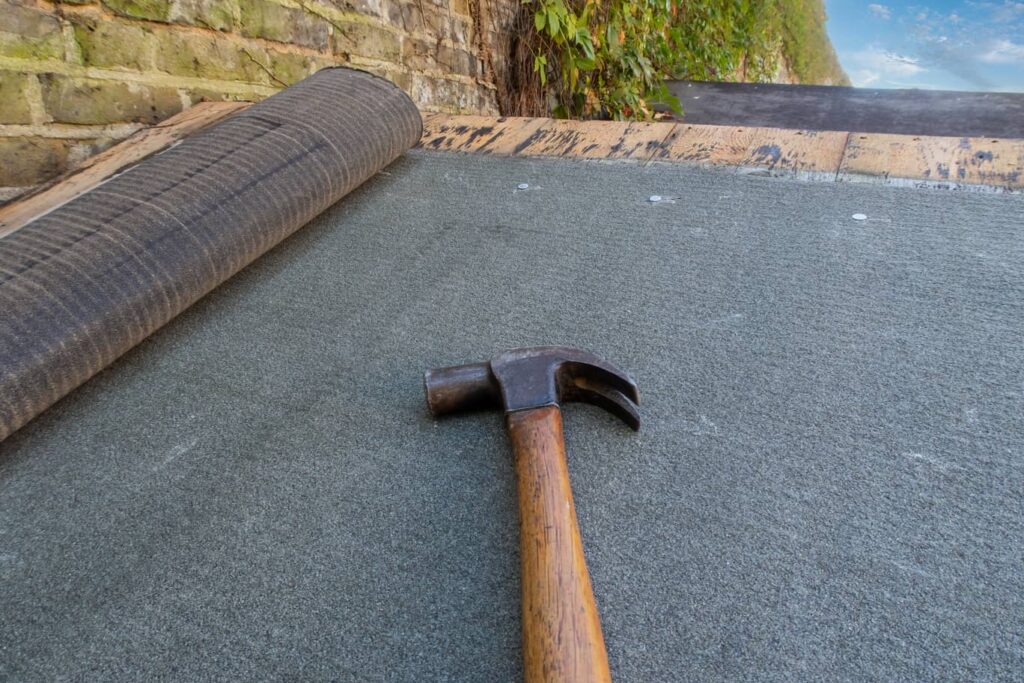Have you ever driven by a new home or a home that is getting a new roof installed? While you were driving by the storm clouds opened up and rain just came thrusting down onto these exposed roofs. Immediately you started thinking to yourself, how is that roof not going to get mold growth because it is getting soaked? Well, hopefully, the roofing felt was in place and protecting the roof decking (plywood) from the rain. Is roofing felt waterproof? Yes, roofing felt is built to repel water and keep snow and ice from penetrating the roof decking.
Let’s take a look below at what roof felt is made of and why it is used.
What Is Roofing Felt
Roofing felt is simply a material that is installed over the roof decking and under the roof shingles. Also, roofing felt is known as synthetic underlayment, roll roofing, or even roofing tar paper. It is made up of a synthetic blend of fiberglass and polyester with a wood cellulose composition and then coated with a protective layer of asphalt. This protective layer allows the felt to repel water and breathe.

Why Is Roofing Felt Used
When it comes to constructing a roof there are many layers. These layers are constructed in a very specific order so that your home maintains the most protection. Let’s take a look at why roofers install roofing felt.
Water Repellent
Wind and snow can often trap water under your shingles. The roofing felt absorbs the water so that the roof decking (plywood) underneath does not become wet. Roofing felt helps prevent mold growth and further damage to your residential roof decking, which could result in leaks.
Backup Protection
As snow and ice sit on top of your roof, the warmth from inside your home will begin to melt the snow or ice dams from within. As this occurs the water can often seep through the shingles and potentially cause damage to the interior of your home. Having roofing felt installed provides an extra layer of protection and safety from any water leaks.
Weather Protection
Over time, shingles can become cracked or damaged. Often, you won’t notice this unless you climb on the roof for a closer look. As your shingles become weathered and damaged, the roofing felt provides added protection, until you can get your shingles replaced.
Fire Rating
Shingles are tested for fire retardant capabilities when roofing felt underlayment is in place. Without the underlayment, the shingles likely will not receive the highest fire rating. In order to meet building codes, the correct correlating roofing felt must be used with its correlated shingles. Your professionally licensed roofer should know these codes.
Roof Decking Protection
As stated before, the roofing felt is in place the be a line of defense against the elements. You do not want your roof decking (plywood) exposed to the elements.
Uniform Look
In many cases, roof decking is not perfectly flat or straight. Wood can warp and slightly change its shape. during installation. Roofing felt underlayment allows you to install shingles on a more uniform-looking surface. Also, this will prevent what is known as a “picture framing” effect, where the pattern of your wood decking can be seen through the pattern of shingles.
Stain Prevention
Roof felt will keep any resin that seeps through your wood decking from getting onto your shingles. If the resin gains access to your shingles, you will notice staining and a compromised roof shingle. This can greatly affect the aesthetics of your roof.
Other Recommended Maintenance
Now that you have an idea of what roofing felt is, you might want to read up on what roof decking is. Understanding these two items will give you a strengthened knowledge of what is involved when it comes to replacing your roof. As a homeowner, you will also be able to have a knowledgeable conversation with your professionally licensed roofing contractor. This ensures that you are both on the same page and you aren’t getting ripped off.
Next, get a better understanding of how often you need to replace your roof. In order to do this, you might want to get your local home inspection company to provide you with a roof inspection checklist, or have them out to conduct a roofing inspection.
Lastly, make sure that you can determine if your roof is causing leaks to form in your basement. A damaged roof could end up having damaged gutters that inevitably will flood the area around your home’s foundation. This will cause water to seep into the ground and keep your basement moist and damp. If this occurs, mold will grow in the basement and eventually reach your main living spaces.

When Do I Call A Professional
Having a new roof installed can be rather stressful. You want to make sure that you hire the most reputable licensed roofing contractor available. For the most part, the costs associated with a new roof are material driven. So, the price point should be fairly equal as you collect quotes from your local roofing contractors. If you aren’t sure who to call for your roofing project, reach out to your local home inspection team. They can tell you if you need a brand-new roof or just some minor repairs. Additionally, they can refer you to a reputable professionally licensed roofing contractor.
Conclusion
When getting a new roof or an old roof repaired it is important to have all of the facts. As a homeowner, being able to speak the language of the contractor is advantageous. You will be able to understand the reason for various price points and how long it should take your licensed roofing contractor to complete the project. Before you go out and spend a lot of money, reach out to your local home inspection team for a roofing inspection. Call on Enviroquest Home Inspections for a roofing and complete home inspection in Harrisburg, PA.
